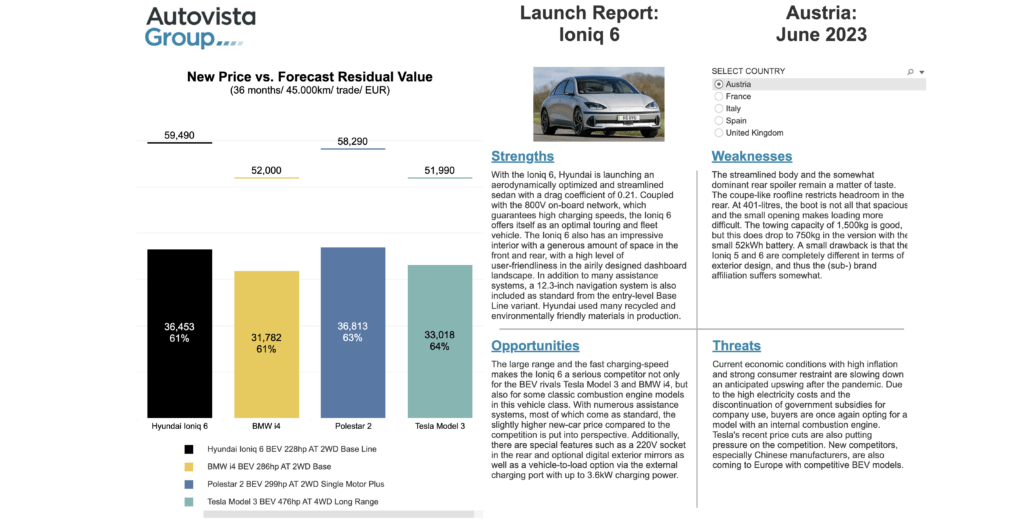Launch Report: Hyundai Ioniq 6 offers streamlined approach to BEV design
03 July 2023

Hyundai’s Ioniq 6 is the second model in the company’s Ioniq sub-brand of battery-electric vehicles (BEVs). It provides a different option to its SUV-based stablemate, positioned as a sedan with coupé styling, giving a look of premium quality while drawing on the carmaker’s increasing expertise in electric-drive technology.
It is a bold choice by Hyundai to make its next sub-brand car more niche than its predecessor. Most manufacturers may decide to launch a hatchback, followed by an SUV, or vice-versa, to target the requirements of different drivers. With the Ioniq 6, Hyundai is proving that it does not care about convention.
Autovista Group experts from Austria, France, Italy, Spain, and the UK analysed the strengths, weaknesses, opportunities, and threats in their respective markets, benchmarking the Hyundai Ioniq 6 against rivals and outlining both new-price points and forecast residual values (RVs). Click on the image below to view their insights in the latest dashboard.
Streamlined design
At the front, the Ioniq 6 is not as bold as its sibling, looking more Telsa-like with its pointed nose and narrow headlights. This design is not just to replicate existing styles. It also aids the aerodynamics of the car, pushing through the air and utilising a steep bonnet curve to help the flow over the roofline.
The rear incorporates two spoilers, a long beam positioned off the rear window, and a lip that sits above the LED rear-light beam. This does give a slightly cluttered look, but again, it helps the airflow over the car and reduces drag, something that can be harmful to an electric vehicle’s (EV) range. The rear bumper also features vertical fog and reversing lights in the squared pattern that is likely to become a symbol of the Ioniq range.
The aerodynamic properties of the Ioniq 6 highlight the thought that needs to go into modern BEV design. Hyundai calls its design a ‘streamliner’, with a drag coefficient of 0.21, one of the lowest in the industry. It certainly helps when it comes to range, reaching up to 614km on a single charge.
For all this slipstreamed design, the Ioniq 6 is more understated than the Ioniq 5. For those put off by the strong design path of the larger SUV, the new saloon would be a better choice. It would have been nice to include more ‘family’ cues, such as the floating square LED bars in the front lights and the angular creases along the side. The VW I.D series, for example, all feature similar front-end designs, highlighting a concept across the class.
Comfortable up front
On the inside, the Ioniq 6 feels much more premium than its sub-brand sibling, with two 12.3-inch screens offering infotainment and driver information. The steering wheel is lacking the standard brand badge, instead featuring four LED lights that can communicate various status updates, including battery status, voice recognition and drive modes. It is a nice touch to put additional alerts front and centre, however, it can be distracting at times.
Interior comfort is aided by the car’s long wheelbase, providing plenty of legroom. However, taller rear passengers will have to mind their heads due to the coupé-style roofline sweeping down at the rear. The Ioniq 6 has a very practical cabin, with plenty of storage space, but this does not translate to the boot, which by saloon standards is very shallow, and has a small opening that could make it awkward to load. Rear-drive versions also benefit from a ‘frunk’ to help store charging cables.
The steering is tight and precise and even at speed, the Ioniq 6 will hold a corner well, giving a feeling of confidence when it comes to handling. The ride itself is quite soft and floaty, while the suspension also picks up bumps and potholes more noticeably than some, yet the comfortable interior helps to reduce the impact for passengers.
The car comes complete with a suite of advanced driver-assistance systems (ADAS), but these can prove troublesome at times. The speed-limit alarm noise is distracting and loud and needs to be deactivated each time you start the vehicle, while the AEB system can bring the car to a complete emergency stop at the slightest detection of a potential collision. Both systems do well to prevent accidents but could do so in a less intrusive way.
Overall, the Ioniq 6 is a good follow-up to the Ioniq 5 and provides those looking for a saloon-based BEV another option against the Tesla Model 3 or Polestar 2. What it may lack in comfort it makes up for in range and ability, and it looks very smart as well. The EV is a good all-rounder that helps to promote the Ioniq line-up as one of quality for Hyundai.
View the Autovista Group dashboard, which benchmarks the new Ioniq 6 in Austria, France, Italy, Spain, and the UK for more details. The interactive launch report presents new prices, forecast residual values, and SWOT (strengths, weaknesses, opportunities, and threats) analysis.




